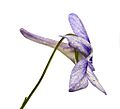Long-spurred violet facts for kids
Quick facts for kids Long-spurred violet |
|
|---|---|
 |
|
| Scientific classification | |
| Genus: |
Viola (plant)
|
| Species: |
rostrata
|
Viola rostrata is a pretty wild flower. People often call it the long-spurred violet. It belongs to the violet family, which is called Violaceae.
This plant grows naturally in eastern North America. You can find it in Canada and the United States. It is common in the Northeast, Midwest, and Appalachian areas.
It likes to grow in forests where the soil is a bit acidic. You might often see it near Eastern hemlock trees.
What Does the Long-Spurred Violet Look Like?
The long-spurred violet is a plant that grows new stems and leaves every year. It has stems that grow upwards.
Its leaves come in two main types:
- Stem leaves: These leaves grow on the stem. They are simple, meaning they are not divided into smaller leaflets. They have small teeth along their edges. Their shape is like an egg, and they come to a sharp point.
- Basal leaves: These leaves grow from the base of the plant, near the ground. They are heart-shaped. They are usually about 2 to 4 centimeters long.
This violet blooms in the spring. Its flowers are a light purple color. They have darker veins that create a darker spot in the middle. A special part of the flower, called the spur, is very long. It is at least as long as the petals themselves. This long spur helps tell it apart from other violets.
How Does the Long-Spurred Violet Mix with Other Plants?
Sometimes, Viola rostrata can create new plants by mixing with other types of violets. This is called hybridizing. It means two different kinds of plants combine their genes to make a new kind of plant.
The long-spurred violet is known to hybridize with:
- Viola conspersa, also known as the American dog-violet.
- Viola striata, which is called the creamy violet.
Images for kids


